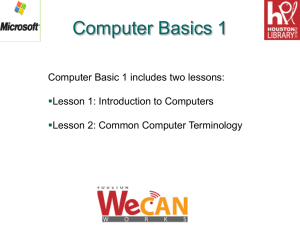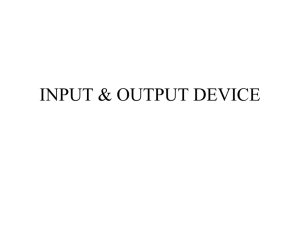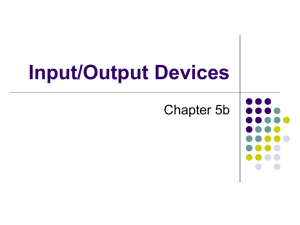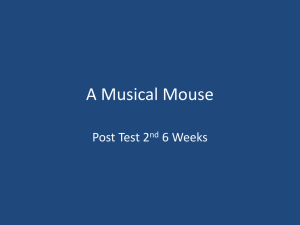Chapter 13B
advertisement
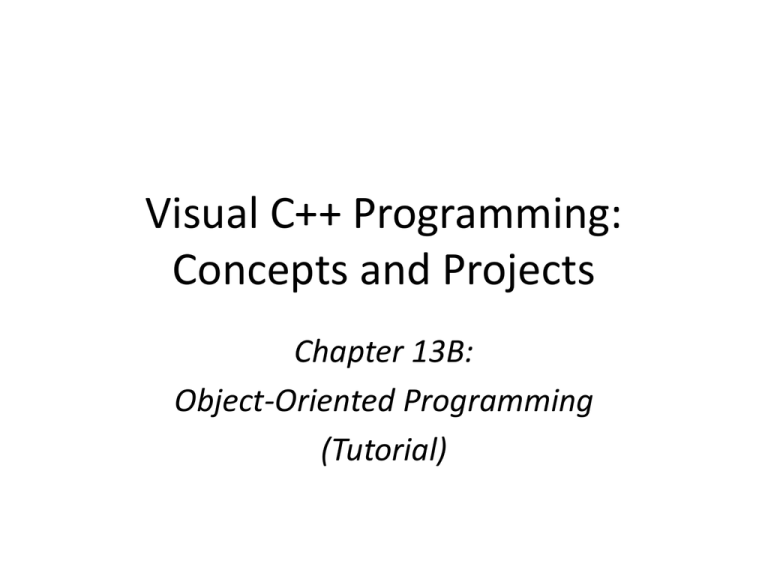
Visual C++ Programming: Concepts and Projects Chapter 13B: Object-Oriented Programming (Tutorial) Tutorial: Maze Program • Problem analysis – Create a program in which a mouse navigates a maze looking for the hidden cheese – The maze consists of a two-dimensional array of cells – The Mouse is an object created from a Mouse class definition – Each cell in the maze is an object created from a Cell class definition Programming with Visual C++ 2 Problem Analysis Programming with Visual C++ 3 The Mouse Class Definition • Class variables – Various icons of mouse facing different directions • private data members – Row and column locations of the mouse in the maze (row and col) – Icon • private methods – Default constructor – Mouse() Programming with Visual C++ 4 The Mouse Class Definition (continued) • public methods – Initializing constructor – Mouse(int, int) – Accessor methods • getRow() • getCol() • getIcon() – Mutator methods • setRow() • setCol() Programming with Visual C++ 5 The Mouse Class Definition (continued) • public methods – Utility methods • • • • goRight() goLeft() goUp() goDown() Programming with Visual C++ 6 The Mouse Class Definition (continued) Programming with Visual C++ 7 The Mouse Class Definition (continued) Programming with Visual C++ 8 The Mouse Class Definition (continued) Programming with Visual C++ 9 Programming with Visual C++ 10 The Cell Class Definition • private data members – row: int – row location of Cell in maze – col: int – column location of Cell in maze – access: bool – indicates whether Mouse can enter this Cell – hasCheese: bool – indicates whether cheese is in this Cell • private methods – Default constructor – Cell() Programming with Visual C++ 11 The Cell Class Definition (continued) • public methods – Initializing constructor – Cell(int, int) – Accessor methods • • • • getRow() getCol() getAccess() getCheese() – Mutator methods • setAccess() • setCheese() Programming with Visual C++ 12 The Cell Class Definition (continued) Programming with Visual C++ 13 Programming with Visual C++ 14 The Cell Class Definition (continued) • An initializing constructor is used to assign each Cell a row and column location as well as a Boolean access value Programming with Visual C++ 15 Design • A maze consists of rows and columns – Rows run horizontally – Columns run vertically • Each cell has a row and column location Programming with Visual C++ 16 Design (continued) Programming with Visual C++ 17 Design (continued) Programming with Visual C++ 18 Design (continued) Programming with Visual C++ 19 Design (continued) • The interface contains two buttons (used to start and stop the animation) • A Timer control is used to perform Mouse movement • The Mouse moves from one Cell to another • Previous cells are colored brown • When the mouse reaches the cell with the cheese, a MessageBox pops up Programming with Visual C++ 20 Design (continued) Programming with Visual C++ 21 Design (continued) • The size of Cells and the number of rows and columns of Cells in the maze are constants Programming with Visual C++ 22 Design (continued) Programming with Visual C++ 23 Design (continued) • The maze is a two-dimensional array of Cells • Use the Array template as a foundation for this Programming with Visual C++ 24 Design (continued) • Instance variables include the mouse, maze, and a variable to indicate which direction the mouse is moving Programming with Visual C++ 25 Design (continued) • Creating the maze requires the instantiation of 320 Cell objects (20 in each row) Programming with Visual C++ 26 Design (continued) • The Form1_Load() event will construct the interface, complete with maze, mouse, and cheese Programming with Visual C++ 27 Design (continued) • Drawing the maze (nested loops for rows and columns) Programming with Visual C++ 28 Design (continued) • Drawing and positioning the Mouse Programming with Visual C++ 29 Design (continued) • Keep the mouse in the maze by checking for edges Programming with Visual C++ 30 Development • • • • Interface construction (only two buttons) Timer control used to control movement Form1_Load() will draw the maze initially The maze and mouse are redrawn in each Timer_Tick() event Programming with Visual C++ 31 Development (continued) Programming with Visual C++ 32 Development (continued) • The Mouse and Cell class definition header files must both be included at the top of the client (Form1.h) Programming with Visual C++ 33 Development (continued) • Instance variables, constants, and object handles Programming with Visual C++ 34 Development (continued) • Form1_Load() constructs the maze Programming with Visual C++ 35 Development (continued) • The start button creates the mouse and cheese Programming with Visual C++ 36 Development (continued) • The mouse and cheese icons are displayed in Rectangles Programming with Visual C++ 37 Development (continued) • The maze cells are drawn in drawMaze() Programming with Visual C++ 38 Development (continued) • At each interval of the Timer, its Tick() event: – Redraws the maze – Draws the mouse at its new location • The animation can be halted with btnStop_Click() Programming with Visual C++ 39 Development (continued) • The Timer1_Tick() event: – Creates a Rectangle based on the cell in which the mouse currently resides (oldRect) Programming with Visual C++ 40 Development (continued) • If mouse is not at edge, then move in current direction Programming with Visual C++ 41 Development (continued) • If mouse moves into cell with cheese, congratulations! • If mouse was at an edge, then choose new direction Programming with Visual C++ 42 Development (continued) • Check for edges by checking row and column Programming with Visual C++ 43 Testing • When btnStart is clicked: – Maze appears (16 rows x 20 columns of cells) – Mouse and cheese appear – Mouse moves across the maze from left to right – When mouse reaches the edge, it turns and follows the edges around • Reposition the cheese so that the mouse finds it in its path Programming with Visual C++ 44 On Your Own • Stronger mutators – Do not allow negative values • Private instance methods – verifyRow() and verifyCol() for Mouse class • New UML class diagram – Add verifyRow() and verifyCol() to Mouse UML diagram Programming with Visual C++ 45




